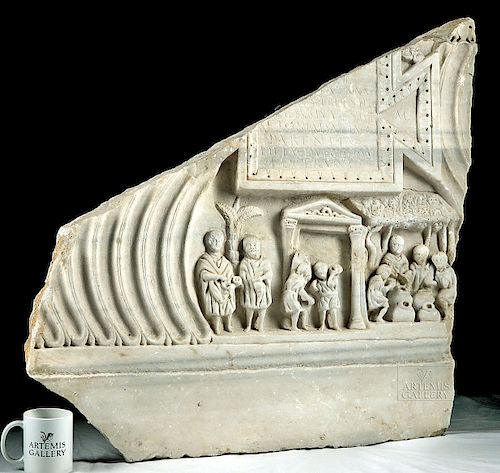Roman Marble Sarcophagus Relief Dedicated to Daughter
Lot 59a
About Seller
Artemis Fine Arts
686 S Taylor Ave, Ste 106
Louisville, CO 80027
United States
Selling antiquities, ancient and ethnographic art online since 1993, Artemis Gallery specializes in Classical Antiquities (Egyptian, Greek, Roman, Near Eastern), Asian, Pre-Columbian, African / Tribal / Oceanographic art. Our extensive inventory includes pottery, stone, metal, wood, glass and textil...Read more
Estimate:
$25,000 - $35,000
Absentee vs Live bid
Two ways to bid:
- Leave a max absentee bid and the platform will bid on your behalf up to your maximum bid during the live auction.
- Bid live during the auction and your bids will be submitted real-time to the auctioneer.
Bid Increments
| Price | Bid Increment |
|---|---|
| $0 | $25 |
| $300 | $50 |
| $1,000 | $100 |
| $2,000 | $250 |
| $5,000 | $500 |
| $10,000 | $1,000 |
| $20,000 | $2,500 |
| $50,000 | $5,000 |
| $100,000 | $10,000 |
| $200,000 | $20,000 |
About Auction
By Artemis Fine Arts
Feb 21, 2019
Set Reminder
2019-02-21 10:00:00
2019-02-21 10:00:00
America/New_York
Bidsquare
Bidsquare : Exceptional Antiquities, Asian, Ethnographic
https://www.bidsquare.com/auctions/artemis-gallery/exceptional-antiquities-asian-ethnographic-3858
An important one-day auction featuring museum-worthy examples of Egyptian, Greek, Roman, Etruscan, Near Eastern, Far East / Asian, Pre-Columbian, African / Tribal, Oceanic, Native American, Spanish Colonial, Russian, Fossils, Ancient Jewelry, Fine Art, so much more! Artemis Fine Arts info@artemisfinearts.com
An important one-day auction featuring museum-worthy examples of Egyptian, Greek, Roman, Etruscan, Near Eastern, Far East / Asian, Pre-Columbian, African / Tribal, Oceanic, Native American, Spanish Colonial, Russian, Fossils, Ancient Jewelry, Fine Art, so much more! Artemis Fine Arts info@artemisfinearts.com
- Lot Description
Roman, Imperial Period, ca. 1st to 3rd century CE. A large section from a marble relief sarcophagus panel with an extensive figural scene at the lower end and a Latin inscription above. The central focus of the scene presents a funerary naiskos - a small temple of the Ionic order in this case - featuring two figures. On the left, just outside the naiskos, is a bearded male - most likely of mature age given his hunched over pose. On the right, is a youthful figure. Both are carrying vessels and are engaged in a discussion. A wreath decorates the pediment above. The youth more definitely occupies the space of the funerary naiskos. Lines from the inscription indicate that the sarcophagus is dedicated to a 16 year old girl by her parents, Aufidius and Setonia Dativa. (See more below). Size: 33.5" W x 31.625" H (85.1 cm x 80.3 cm)
To the left are two bearded men in togas engaged in a discussion, with the man on the right holding a vessel before a palm tree or papyrus plant. To the right is a group of four draped figures gathered around four vessels similar to the one held by the man to the left of the naiskos, beneath a foliage-covered canopy of a shade structure. The theme of this iconography seems to revolve around commerce, which was a major focus of the Roman economy. Perhaps this sarcophagus was created for the adolescent daughter of a prominent merchant family.
The surviving inscription segments read as follows: ]AE / [VIXI]T ANN XVI / [MENS]IB V DIEB XIIII / [AU]FIDIUS IUVENIS ET / SETONIA DATIVA / PARENTES FILIAE DULCISSIMAE FECERUNT - This translates: "… for ___ / Lived 16 years, 5 months, and 14 days. / Her parents, the young Aufidius and Setonia Dativa, have made [this] for their sweetest daughter."
Prior to the 2nd century, Romans cremated their dead; around that time, inspired by the Greek and Etruscan practice of using sarcophagi, they began to place the deceased in sarcophagi. This trend spread rapidly throughout the Roman Empire. In the western part of the Empire, sarcophagi were placed inside a mausoleum against a wall or in a niche, so the only decorated panels were on the front and the short sides. Based on the level of society that attended banquets, this panel probably came from the grave of an elite Roman citizen.
Provenance: private East Coast, USA collection; ex-Dr. Sid Port collection, California, USA, acquired in the 1980s
All items legal to buy/sell under U.S. Statute covering cultural patrimony Code 2600, CHAPTER 14, and are guaranteed to be as described or your money back.
A Certificate of Authenticity will accompany all winning bids.
We ship worldwide and handle all shipping in-house for your convenience.
#143956A very large section from a sarcophagus marble relief panel. Repaired from two large pieces with stabilization around the break line. Expected surface wear and abrasions to high pointed areas commensurate with age, but the relief imagery is still vivid.Condition
- Shipping Info
-
All shipping is handled in-house for your convenience. Your invoice from Artemis Gallery will include shipping calculation instructions. If in doubt, please inquire BEFORE bidding for estimated shipping costs for individual items.
-
- Buyer's Premium



 EUR
EUR CAD
CAD AUD
AUD GBP
GBP MXN
MXN HKD
HKD CNY
CNY MYR
MYR SEK
SEK SGD
SGD CHF
CHF THB
THB
















